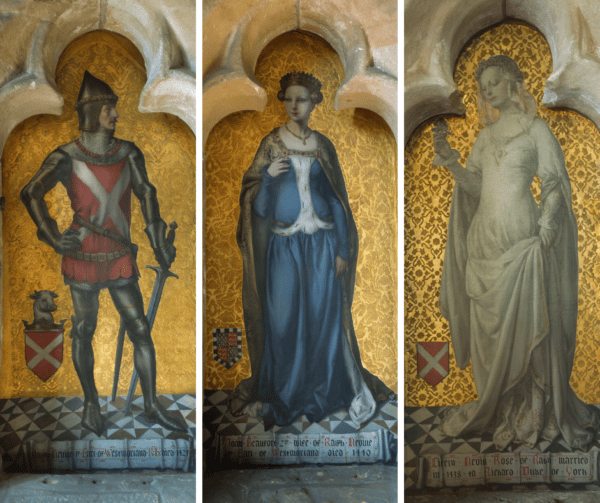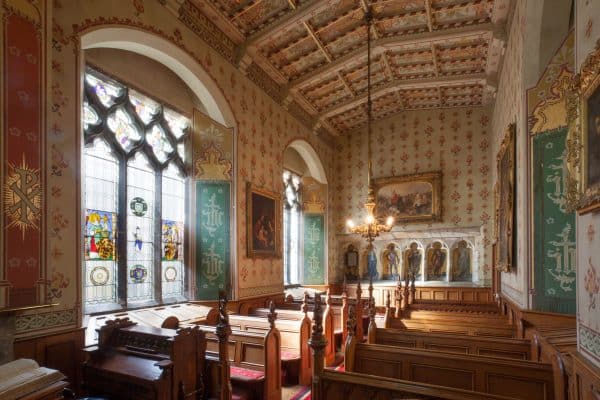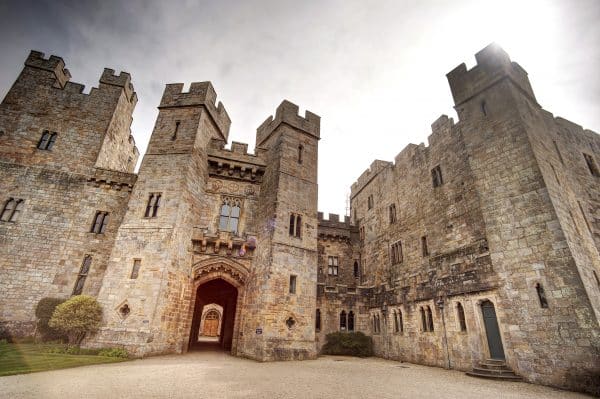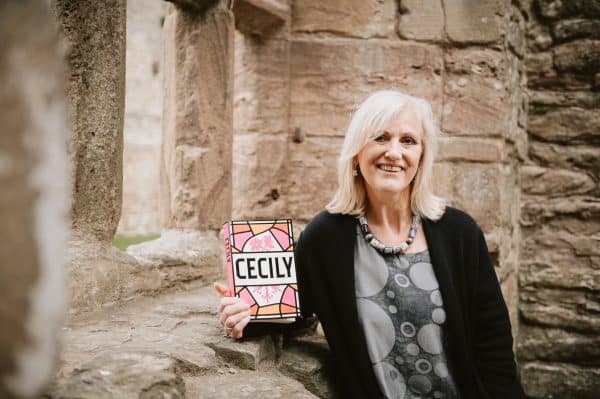We are delighted to be taking part in Historic Houses’ #MedievalMondays initiative, to share special stories and pieces from our collections at Raby. For our latest theme, Betrothals and Marriages, we caught up with Castle Curator, Julie Biddlecombe-Brown to explore one of the most famous betrothals connected with Raby. Read on to find out more…
Raby Castle and the betrothal that changed the face of England
As the year 1423 turned to 1424, the youngest daughter of Ralph, Earl of Westmorland of Raby Castle and his wife, Joan Beaufort, half-sister to the King, was formally betrothed to her parents’ 13-year-old ward. No ordinary couple, the future bride and groom were Cecily Neville and Richard Duke of York and their union, meticulously planned by her parents, heralded a politically strategic marriage that changed the course of British history.

Depictions of Ralph, Joan and Cecily Neville in the Chapel at Raby Castle
The teenage Richard first met Cecily when he travelled to Raby Castle after his wardship was formalised. Unlike many aristocratic couples in the 15th century, they probably had the opportunity to get to know one another before their betrothal. The ceremony, which formally pledged their intent to marry when the bride came of age, took place in County Durham, either at Raby Castle or close by in Staindrop Church. The exact date of their marriage is not known but possibly after Cecily’s twelfth birthday in 1427. They were certainly married by 1429. No evidence survives to confirm that the wedding took place at Raby although at least one of Cecily’s sisters was married in the chapel so it is possible that the young couple wed in her childhood home.

The Chapel at Raby Castle
The momentous impact of the betrothal and marriage of this young girl and teenage boy, rocked England during the decades that followed. Standing at the altar, the young couple could never have imagined the turbulent future that was to unfold. During their lifetimes they would become central to the Yorkist claim to the throne during the Wars of the Roses. During the lifetimes of their children, England witnessed some of the most destructive and divisive family relationships in its history; two of their sons became King and their grand-daughter a Queen through which the present day Royalty can trace its lineage.
We asked Annie Garthwaite, whose first novel Cecily will be released this summer, to reflect on Cecily and Richard’s betrothal at Raby, their marriage and relationship. Annie writes…
“Cecily’s was arguably the most brilliant of a series of dazzling marriages that Ralph and Joan made for their children. Cecily was betrothed late in 1423 at the age of eight to Richard Plantagenet, heir to the earldom of Cambridge and dukedom of York. It was a promising match, but not without risk for, as well as being heir to prestigious titles, Richard was also the son of a traitor. His father, Richard Earl of Cambridge, had been executed by Henry V in 1415 for his part in the Southampton plot. To secure his inheritance, the young Richard would have to win the favour of the present King Henry VI. Unless Henry confirmed Richard’s titles at his coming of age, he would not receive them and Cecily’s brilliant marriage would have lost its lustre. One can only imagine that Ralph took upon himself a mission to make a ‘king’s man’ of Richard, to imbibe him with Lancastrian loyalties, to ensure his smooth accession to his titles and, effectively, co-opt the wealth and prestige of those titles into his own family.
Two years later, both the brilliance of the marriage and its risks became greater still. When Richard’s maternal uncle Edmund Mortimer, the fifth earl of March, died childless in 1425, Richard became heir to a vast Mortimer inheritance. All good. However, that inheritance also brought with it a claim to the English throne that rivalled that of the present king. Henry VI took his royal claim from Edward III’s third son, John of Gaunt. Richard, meanwhile, could claim direct descent from Edward’s second son, Lionel Duke of Clarence, and his fourth, Edmund Duke of York.

The Neville Gateway at Raby Castle, Cecily’s childhood home
The fact of Richard’s royal claim dogged their married life and though conspicuously loyal to Henry VI, Richard was always under suspicion. Despite this, Cecily’s closeness to Richard is evident. They spent time together whenever possible and she accompanied him on his travels to France and Ireland when royal duties took him there. She bore him twelve children, lost five in infancy, but succeeded in bringing four sons and three daughters to adulthood. She had a long wait for children, however. Though Richard and Cecily began their married life together in around 1431, she had to wait eight years, until 1439, to deliver a living child (a daughter, Anne) and another three to bring forth a son (Edward) that survived infancy. This must have been challenging. Of the many demands placed upon a medieval aristocratic woman, the greatest was to bear children. But there is no evidence that Cecily’s early failure in this regard led to any fracture in her marriage. She and Richard appear to have remained close during this time and, since there is no evidence that Richard owned any bastards, it seems likely he was faithful or, at least, discreet. Fortunately, after a slow start, Cecily’s childbearing potential – and her ability to deliver strong sons – became one of her most valuable assets.
Rumours emerged, later in Cecily’s life and after her husband’s death, that her eldest living son, by this time Edward IV, was not in fact Richard Duke of York’s child. Whilst these can’t be entirely disregarded, the story is unlikely and the evidence scant. It’s worth noting that the rumours emerged in the French court and while Cecily’s nephew, the Earl of Warwick, and second son, George Duke of Clarence, were in league with France in rebellion against Edward. Accusations of bastardy were effective weapons of war at a time when the right of kings depended upon legitimate descent.
But back to Cecily’s marriage. As her husband Richard’s loss of royal favour became increasingly serious, Cecily shows every sign of striving to revive it. Like Richard, she seems to been at pains to persevere in loyalty to the crown for as long as possible. In 1453, for example, she petitions Queen Marguerite on her husband’s behalf, begging no favour but that he be returned to the king’s good graces. However, it seems to me that, as matters progressed from bad to worse, Cecily must have come to recognise that she and Richard faced a stark choice – either to take power or be destroyed by it. As a wife and mother, and as a woman of high noble birth, I can well imagine she might have reached the conclusion that the only place of safety for her husband – and by extension, her sons – was on the throne.”

Annie Garthwaite with her debut novel, Cecily. Image credit: MNA Media
Annie Garthwaite’s debut novel Cecily, will be published by Penguin on 29 July and can be pre-ordered now from all good high street and online book retailers. You will also be able to pick up a copy from our Stables Shop at Raby Castle. We caught up with Annie for an exclusive Q&A to find out more about Cecily. This will be released on our blog soon.
To explore more Historic Houses themes from Raby, read our #FeatureFridays blog post.
Raby Castle is open Tuesday – Sunday from 11am.
The Park and Gardens are open daily from 10am – 4pm.
If you’d like to learn more about Cecily and see her portrait in the Chapel, you can book tickets to the Castle, Park and Gardens on our website.

